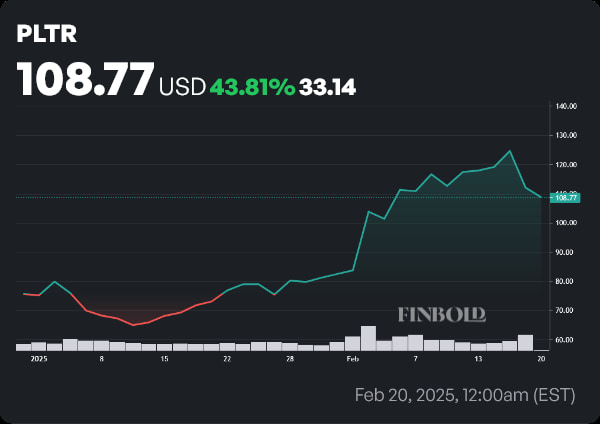On Wednesday, February 19, Palantir stock (NASDAQ: PLTR) crashed by 12.71% — by press time, PLTR shares were changing hands for $108.77, down from an all-time high (ATH) of $124.62 just a day earlier.

Palantir’s meteoric rise was not without its detractors. The data analytics company, a longtime favorite of retail investors, did not enjoy a lot of confidence from Wall Street. While that sentiment gradually changed, analysts generally remained divided — and on average, their price targets projected significant downside, despite a string of standout earnings quarters.
Two of the key factors often cited by researchers when explaining their bearishness were the company’s high valuation and its overreliance on government contracts. In addition, key company insiders have been relentless when it comes to selling PLTR stock — with more than $40 million in insider sales made just in the first month of the year.
Now, it seems that all of these components have come to a head — let’s take a closer look at why the markets reacted as strongly as they did.
Palantir stock plummets on defense cuts, insider sales
Secretary of Defense Pete Hegseth’s newly released plan calls for an 8% reduction in the Pentagon’s budget each year for the next five years, making it the first bearish catalyst at play.
Understandably, defense contractors such as Palantir would most likely be hit hard by these cuts — and the data analytics company, with its high valuation, is particularly vulnerable to stock price pullbacks on account of such changes.
Per Palantir’s annual Form 10-K filing made public on February 18, the company derives roughly 55% of its total revenue from government contracts — while 66% of total revenue comes from the United States.

A closer look at the filing reveals another potential bearish catalyst. Chief executive officer (CEO) Alex Karp adopted a new 10b5-1 trading plan on December 11, 2024. These plans allow major shareholders or key insiders, including company personnel, to dispose of their shares by prescheduling trades.
Per the new plan, Karp could sell as many as 9,975,000 units of Palantir stock by September 12, 2025.

To put that into perspective, such a sale would be worth $1.08 billion — and we’re taking current, post-crash prices as a starting point here.
With all of that being said, readers should note that efforts to curtail or even audit the Pentagon’s spending have historically proven rather fruitless.
Featured image via Shutterstock








